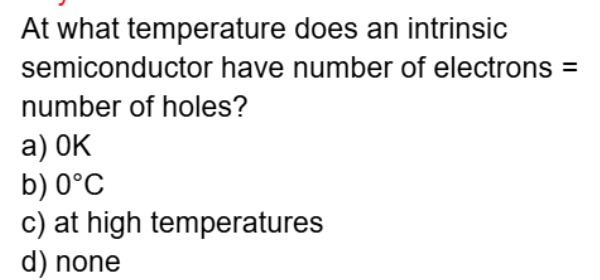Question
Question: At what temperature does an intrinsic semiconductor have number of electrons = number of holes?...
At what temperature does an intrinsic semiconductor have number of electrons = number of holes?

0K
0°C
at high temperatures
none
d
Solution
An intrinsic semiconductor is a pure semiconductor material. In such a material, charge carriers (electrons and holes) are generated in pairs due to thermal excitation. When an electron gains enough thermal energy to break a covalent bond and move into the conduction band, it leaves behind a vacancy called a hole in the valence band. This process ensures that for every free electron created, one hole is also created.
Therefore, in an intrinsic semiconductor, the number of free electrons (ne) is always equal to the number of holes (nh). This equality holds true at:
- 0 K (Absolute Zero): At this temperature, there is ideally no thermal energy, so no electron-hole pairs are generated. Thus, ne=0 and nh=0. In this case, ne=nh is satisfied.
- Temperatures above 0 K (e.g., 0°C, room temperature, high temperatures): As the temperature increases, more thermal energy is available, leading to the generation of more electron-hole pairs. However, for every electron promoted to the conduction band, a hole is created in the valence band. Consequently, the number of electrons always remains equal to the number of holes (ne=nh>0).
Since the condition ne=nh is a fundamental characteristic of an intrinsic semiconductor that holds true at all temperatures (where it behaves as an intrinsic semiconductor), none of the options (0K, 0°C, or high temperatures) is the exclusive temperature at which this occurs. It occurs at all of them. Hence, the most appropriate answer is "none".
